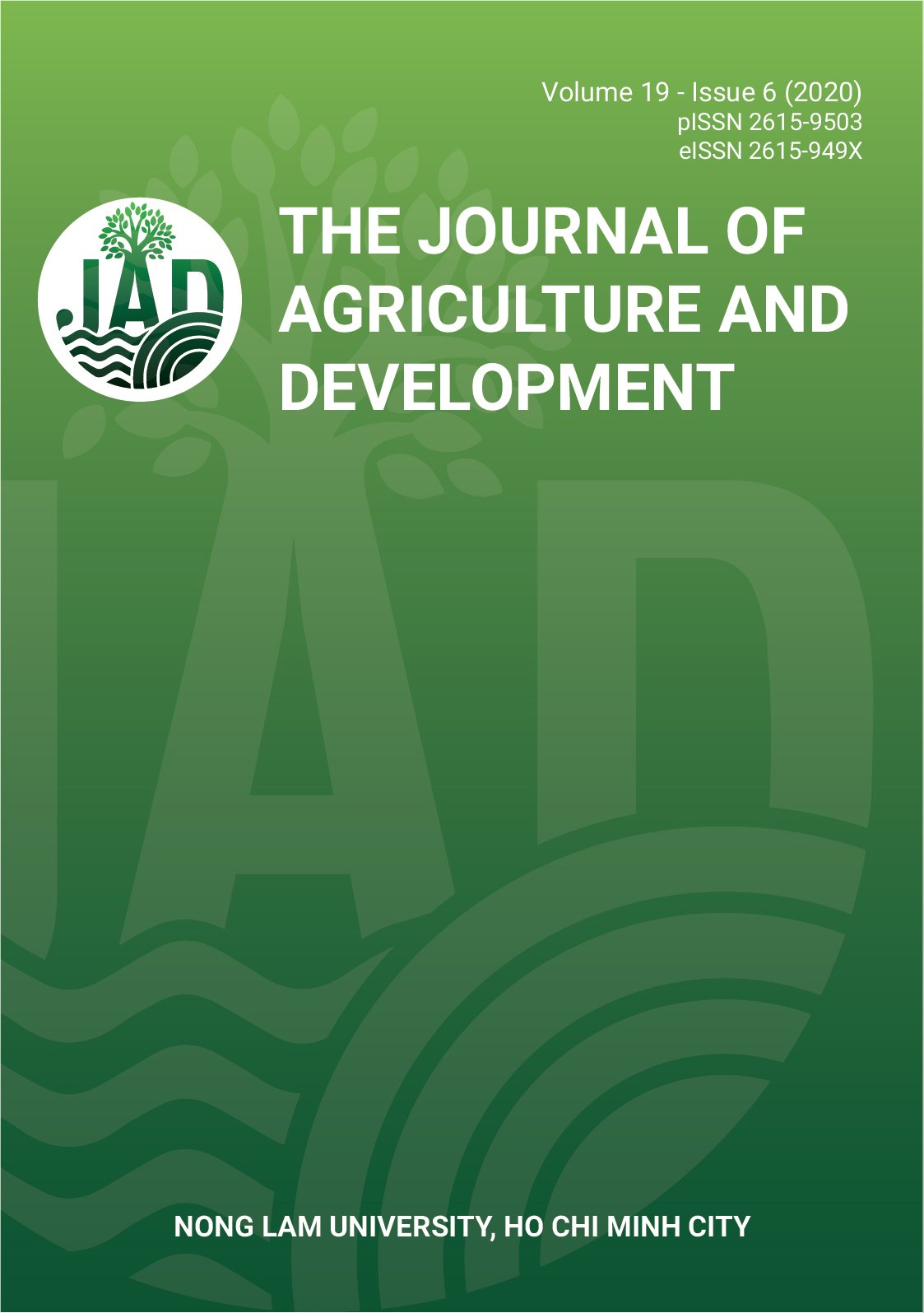Seroprevalence of serotype O of foot-and-mouth disease virus in vaccinated pigs and cattle in Ho Chi Minh City
Main Article Content
Abstract
The aim of this study was to assess the seroprevalence against serotype O FMD (foot and mouth disease) virus in vaccinated pigs and cattle in Ho Chi Minh City, as a basis to serve the prevention of FMD epidemics in these animals. A total of 535 pigs and 366 cattle sera were tested by using the Elisa kit for the detection of serotype O FMD antibody (Pirbright, UK). Results of this study showed that most pig farms had the proportions of positive animals for antibodies against FMDV serotype O which met the requirements of Decision no. 07/2016/Ministry of Agriculture and Rural Development, except Xuan Thoi Thuong, Thai My and Phu My Hung. All sows had high levels of antibodies against serotype O FMD virus. There were no significant differences in the ratios of positive pigs for antibodies against FMDV serotype O among types of pig and age groups. However, there were significant differences in the seroprevalence of vaccinated pigs across herd sizes and days post-vaccination. Meanwhile, the overall seroprevalence of vaccinated cattle against FMDV at individual-level was over 80.00%. No statistical differences were found in the seroprevalence of vaccinated cattle against type O FMDV among regions, types of cattle, herd sizes, age groups and days post-vaccination. In conclusion, pigs raised in farms of Xuan Thoi Thuong, Thai My and Phu My Hung communes should be revaccinated with FMD vaccine to prevent the risk of pigs being infected with FMD virus and reduce the amount of virus produced by an infected animal.
Article Details
References
Dekker, A., Gilles, C., Norbert, S., & Phaedra, L. E. (2016). Proper timing of foot-and-mouth disease vaccination of piglets with maternally derived antibodies will maximize expected protection levels. Frontiers in Veterinary Science 3. https://doi.org/10.3389/fvets.2016.00052
Doel, T. R. (1999). Optimisation of the immune response to foot-and-mouth disease vaccines. Vaccine 17(13–14), 1767-1771. https://doi.org/10.1016/S0264-410X(98)00444-7
Ferreira, H. C., Pauszek, S. J., Ludi, A., Huston, C. L., Pacheco, J. M., Le, V. T., Nguyen, P. T., Bui, H. H., Nguyen, T. D., Nguyen, T., Nguyen, T. T., Ngo, L. T., Do, D. H., Rodriguez, L., & Arzt, J. (2015). An integrative analysis of foot-and-mouth disease virus carriers in Vietnam achieved through targeted surveillance and molecular epidemiology. Transboundary and Emerging Diseases 64(2), 547-563. https://doi.org/10.1111/tbed.12403
Kitching, R. P., & Alexandersen, S. (2003). Clinical variation in foot and mouth disease: Pigs. Revue Scientifique et Technique (International Office of Epizootics) 21(3), 513-518. http://dx.doi.org/10.20506/rst.21.3.1367
Lyon, N. A., Lyoo, Y. S., King, D. P., & Paton, D. J. (2016). Challenges of generating and maintaining protective vaccine-induced immune responses for foot-and-mouth disease virus in pigs. Veterinary Science 3, 102. https://doi.org/10.3389/fvets.2016.00102
MARD (Ministry of Agriculture and Rural Development). (2016). The Decision no.07/2016/ about the national program of controlling foot and mouth disease for the period 2016-2020. Retrieved September 29, 2016, from https://thuvienphapluat.vn/.
Miller, C. A. J., Young J. R., Nampanya, S., Khounsy, S., Singanallur, N. B., Vosloo, W., Abila, R., Hamilton, S. A., Bush, R. D., & Windsor, P. A. (2018). Risk factors for emergence of exotic foot-and-mouth disease O/ME-SA/Ind-2001d on small holder farms in the Greater Mekong Subregion. Preventive Veterinary Medicine 159, 115-122. https://doi.org/10.1016/j.prevetmed.2018.09.007
OIE(OIE/FAO Reference Laboratory Network for Foot-and-Mouth Disease). (2018). Viet-nam (Hanoi) porcine, control. Retrieved December 08, 2018, from https://www.foot-and-mouth.org/news/2018/12/vietnam-hanoi-porcine-control.
Orsel, K., & Bouma, A. (2009). The effect of foot-and-mouth disease (FMD) vaccination on virus transmission and the significance for the field. Canadian Veterinary Journal 50(10), 1059-1063.
Parida, S. (2009). Vaccination against foot-and-mouth disease virus: Strategies and effectiveness. Expert review of vaccines 8(3), 347-365. https://doi.org/10.1586/14760584.8.3.347
Park, M. E., You, S. H., Lee, S. Y., Lee, K. N., Ko, M. K., Choi, J. H., Kim, B., Lee, J. S., & Park, J. H. (2017). Immune responses in pigs and cattle vaccinated with half-volume foot-and-mouth disease vaccine. Journal of Veterinary Science 18(S1), 323-331. https://doi.org/10.4142/jvs.2017.18.S1.323
Rweyemamu, M., Roeder, P., Mackay, D., Sumption, K., Brownlie, J., Leforban, Y., Valarcher, J. F., Knowles, N. J., & Saraiva, V. (2008). Epidemiological patterns of foot and mouth disease worldwide. Transboundary and Emerging Diseases 55(1), 57-72. https://doi.org/10.1111/j.1865-1682.2007.01013.x
Truong, B. D. (2017). Participatory methods in surveil-lance and control of foot-and-mouth disease: How to better involve the farmers at a local scale? (Unpublished doctoral dissertation). University of Toulouse, Toulouse, France.








